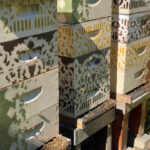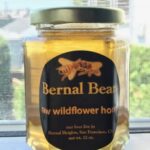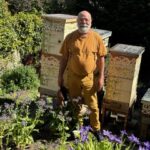Welcome to an exciting interview with Peridot, the esteemed beekeeper of Bernal Bears! Nestled in the heart of Bernal Heights, San Francisco, Peridot has dedicated his life to the enchanting world of bees and the preservation of their vital role in our ecosystem. With their deep-rooted passion and extensive knowledge, he has become a local icon, fostering a harmonious relationship between humans and these incredible pollinators.
In this exclusive interview, we delve into his captivating journey as a beekeeper, exploring his motivations, experiences, and the incredible impact of their work. Join us as we uncover the buzzing secrets of Bernal Heights and gain invaluable insights into the vital importance of bees in our world today.
Get inspired by Peridot’s remarkable dedication and discover the fascinating world of beekeeping like never before!
Buzzing with Peridot: An Insightful Interview with Bernal Heights Beekeeper Extraordinaire
How did you start as a beekeeper, and what motivated you to start Bernal Bears, Honey?
My daughter had a beehive, and I was fascinated by sitting and watching the bees come and go. She made it look so easy, so I decided to get involved. I was glad I started with two hives because I quickly realized this was more than a simple hobby. Then, after keeping bees for a few years, I realized I would never eat or give away as much honey as my bees were producing. I started to sell honey to friends in my community circles. Bernal Bears was born.
What makes Bernal Heights an ideal location for beekeeping?
San Francisco has mild weather year-round and many irrigated gardens and street trees, providing honeybees year-round foraging opportunities. My South Bernal hives face the sun in a wind-sheltered backyard. This creates a year-round warm and gentle exposure in which the hives thrive. We are located near multiple and various sources of pollen and nectar, including but not limited to the vehicular Bernal Cut with lots of fennel, Alemany Farm with lots of vegetables, Holly Park with eucalyptus trees and Bernal Hill with lots of native shrubs.
Could you tell us about the different types of honey produced by SF Bears Honey and their unique flavors?
Fennel honey is one of my favorite honey. It comes when the fennel blooms in the Bernal Cut on San Jose Avenue. Other favorites are Eucalyptus honey from the winter bloom is buttery and rich; Early spring honey is the most flowery; Ivy honey comes in November and crystallizes very quickly.
What challenges do you face as a beekeeper in an urban environment like Bernal Heights?
The biggest challenge I face in South Bernal is the gusting wind flowing in the Highway 280 corridor. The periodic wind flow makes it difficult for young queen bees to mate because they do their aerial mating acrobatics 200 feet in the air. Only about 30% are successful, so I get more queens from swarms I rescue or queens I purchase.
How do you ensure the health and well-being of your honeybees?
I usually do not wear protective equipment to see and feel the bees as I work with them. I use smoke to keep them calm as I open the hive. I make sure they have room for brood and honey. If they run out of space, the queen and half of the bees may swarm to a new home. I monitor the hives monthly for varroa mites, the biggest killer of honeybee colonies today, and treat them with organic acids common in tart fruits. I replace old combs and frames to ensure the hives provide a healthy environment for brood, house bees, and forager honeybee life cycles. I balance resources between hives to help a weak colony or manage space for brood and honey.

Buzzing with Peridot: An Insightful Interview with Bernal Heights Beekeeper Extraordinaire
Do you follow any specific sustainability practices in your beekeeping operations?
I use only glass jars with metal lids. I offer a credit for returned jars so they can be reused. I use wax foundation for the frames in the hive rather than plastic. It’s no surprise that the bees resist making comb on plastic. I make a lot of the beehive parts with repurposed lumber. I use smoke to calm the bees and egg cartons or repurposed packing materials to fuel the smoker.
What role do honeybees play in the local ecosystem, and how does Bernal Bears Honey contribute to their conservation?
Bees pollinate 70% of our food crops. Being a few blocks from Alemany Farm lets our bees contribute directly to the local food supply. Many fruit trees in the neighborhood have more fruit when bees are nearby. Our lemon tree went from 200 lemons yearly to 1,000 when we got the bees. Now we have calamondin, pineapple, guava, and lime trees. Flowers also make more seeds when bees visit.
Are there any seasonal variations in honey production in Bernal Heights, and if so, how do you manage them?
Most of the honey comes in early spring and fall because of the flowering trees. We have a lot of eucalyptus in San Francisco, which blooms in the winter, some years a lot more than others. The weather plays a big role in honey production. When things bloom, honey production increases significantly. In 2021 I harvested honey every month, but in the first six months of 2023, I only harvested once.
Can you share interesting or unusual facts about honeybees or beekeeping that most people might not know?
Honeybees are not aggressive and will only sting if they are threatened. You can watch them closely as they drink from the flowers; they won’t mind. They are looking for nectar and pollen, not picnic food or people.
All honey crystallizes. How soon depends on the flowers the nectar came from, whether the honey was heated and filtered or strained, and whether there are additives like corn or sugar syrup. Crystallization does not affect honey’s taste but makes it easier to spread on toast, and it tastes better when the crystals take a while to dissolve on your tongue! If you want to liquefy crystallized honey, melt it gently in a microwave for a few seconds, or heat the jar in a pan of water, stirring to keep it from getting hot as it melts.
60% of the honey sold on the planet is fake or diluted.
Although honeybees and native bees are greatly harmed by habitat reduction, mono-cropping, and pesticides, local urban beekeepers are skilled at propagating bees and can replace lost hives. Nevertheless, more than half of all honeybee hives die each year.
How can the local community in Bernal Heights support SF Bears Honey and help promote bee conservation?
Do not use pesticides in your garden or pollinator-friendly ones if you must—plant pollinator-friendly trees and plants. Buy local honey to support community beekeepers, rather than big box store honey that is likely laced with corn syrup and heated in production.
You can buy Bernal Bears Honey online or at Little Bee Baking, Avedano’s Meats, and Harvest Hills Market.




